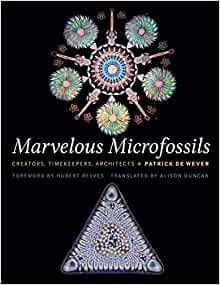Marvelous Microfossils: Creators, Timekeepers, Architects
By Patrick De Wever, foreword by Hubert Reeves and translated by Alison Duncan

This is a lovely book – a glorious mixture of a beautiful coffee-table book and an academic treatise of the highest quality. In his review of the book, Rémi Luglia (President of Société Nationale de Protection de la Nature) describes it as follows:
“Enhanced by sumptuous images, Marvelous Microfossils reveals microfossils’ amazing forms and fascinating architecture. Readers will be easily hypnotized by their patterns, their rhythms, their symmetries… a delight for the eyes, this book is also notable for its scientific intelligibility.”
Every page contains wonderful, full colour, glossy pictures and it is worth, at first, just flicking through them without reading a word, as if wandering through an art gallery. However, at the same time, the book provides an introduction to the marvellous world of microfossils, an explanation of what they are and the reason why it is important to study them.
But why microfossils? What is it about them that can create such strong feelings? Well, as the book states:
Microfossils – the most abundant, ancient, and easily accessible of Earth’s fossils – are also the most important. Their ubiquity is such that every person on the planet touches or uses them every single day, and yet few of us even realize that they exist. Despite being the sole witnesses of 3 billion years of evolutionary history, these diminutive fungi, plants, and animals are themselves invisible to the naked eye. In this microscopic bestiary, prominent geologist, palaeontologist and scholar Patrick De Wever lifts the veil on the mysterious world.”
The latter issue is discussed in its own part (Part A), which covers such things as the application of microfossils to age-dating rocks and to palaeoenvironmental reconstruction, which in turn guides the huge financial investment in oil, gas and mining. The author also explains how, for instance, microfossils made the Channel Tunnel possible and their surprising role in catching wrongdoers involved in such crimes as jewel thefts and murder.
Part B discusses microfossils throughout the geological past and Part C their immense diversity. The final part (D) is both pragmatic and ethereal, taking the same title as the subtitle to the book: “Architects, creators and markers of time”. The section covers how microfossils have influenced, for example, architecture and art deco, as well as their role in geology and the passage of geological time.
To put it bluntly, Marvelous Microfossils is great choice for a Christmas or birthday present for the discerning! Or maybe just a present for yourself. I couldn’t recommend it more.
Patrick De Wever is a professor of geology and micropaleontology at the Museum national d’Histoire naturelle. He is the author of Temps de la Terre, temps de l’Homme and Carnet de curiosites d’un geologue, among others.
Alison Duncan is a translator and book editor. She earned her master of science in translation from New York University and her bachelor of arts in French and Francophone studies from Vassar College.
Marvelous Microfossils: Creators, Timekeepers, Architects, by Patrick De Wever, foreword by Hubert Reeves, translated by Alison Duncan, The John Hopkins University Press, Baltimore, Maryland, USA (2020), illustrated edition, 255 pages (hardback), ISBN-13: 978-1421436739